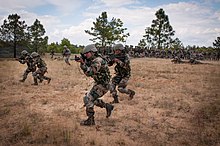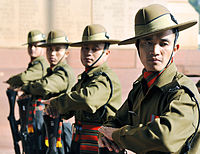REGIMENTS
Infantry regiments[edit]
Upon its inception, the Indian Army inherited the British Army's organisational structure, which is still maintained today. Therefore, like its predecessor, an Indian infantry regiment's responsibility is not to undertake field operations but to provide battalions and well trained personnel to the field formations, as such it is common to find battalions of the same regiment spread across several brigades, divisions, corps, commands, and even theatres. Like its British and commonwealth counterparts troops enlisted within the regiment are immensely loyal and take great pride in the regiment to which they are assigned and generally spend their entire career within the regiment.
Infantry regiments of the Indian Army recruit based on certain selection criteria, such as on regional, ethnicity, or religion such as theAssam Regiment, Jat Regiment, and Sikh Regiment respectively. Most of them continue the heritage of regiments raised under the Raj, but the Ladakh Scouts, Arunachal Scouts, and Sikkim Scouts, specialised in border defence, have been raised since independence.
Over the years various political and military factions have tried to dissolve the unique selection criteria process of the regiments over a fear that loyalty to the regiment or its ethnic people opposed to loyalty to the union of India and have succeeded somewhat with the creation of ethnic-less, religion-less, non-regional regiments, such as the Brigade of Guards and Parachute Regiment, but have generally met with little success or gained popular support amongst the rank and file Jawans.
Regiments in order of seniority within the Indian Army are:[90]
- Brigade of the Guards
- Parachute Regiment
- Mechanised Infantry Regiment
- Punjab Regiment
- The Madras Regiment
- The Grenadiers
- Maratha Light Infantry
- Rajputana Rifles
- Rajput Regiment
- Jat Regiment
- Sikh Regiment
- Sikh Light Infantry
- Dogra Regiment
- The Garhwal Rifles
- Kumaon Regiment
- Assam Regiment
- Bihar Regiment
- Mahar Regiment
- Jammu & Kashmir Rifles
- Jammu & Kashmir Light Infantry
- Naga Regiment
- 1 Gorkha Rifles (The Malaun Regiment)
- 3 Gorkha Rifles
- 4 Gorkha Rifles
- 5 Gorkha Rifles (Frontier Force)
- 8 Gorkha Rifles
- 9 Gorkha Rifles
- 11 Gorkha Rifles
- Ladakh Scouts
- Rashtriya Rifles
- Arunachal Scouts
- Sikkim Scouts
Artillery regiments[edit]
The Regiment of Artillery once constituted a formidable operational arm of Indian Army. During the Kargil War, it was the Indian Artillery that inflicted the most amount of damage.[91] The role played by the artillery was praised by the top army brass, the divisional commander, a brigade commander and a battalion commander. Two of the officers were then General V.P. Malik, then Lieutenant General S. Padmanabhan[92] both of whom went on to serve as Chief of Army Staff.
Historically it takes its lineage from Moghul Emperor Babur who is popularly credited with introduction of Artillery in India, in the Battle of Panipat in 1526.[citation needed] However evidence of earlier use of gun by Bahmani Kings in the Battle of Adoni in 1368 and King Mohammed Shah of Gujrat in fifteenth century have been recorded.[citation needed]
After undergoing consistent failures to import or produce modern artillery for three decades,[93][94] the Regiment of Artillery is finally going ahead with procurement of brand new 130-mm and 150-mm artillery guns.[95][96][97]
Armoured regiments[edit]
There are 63 armoured regiments in the Indian Army. These include the following historic regiments dating back to the nineteenth century or earlier: 1st (Skinner's) Horse, the2nd Lancers (Gardner's Horse), 3rd Cavalry, 4th (Hodson's) Horse, 7th Light Cavalry, 8th Light Cavalry, 9th (Deccan) Horse, 14th (Scinde) Horse, 17th (Poona) Horse, 15th Lancers, 16th Light Cavalry, 18th Cavalry, 20th Lancers, and the 21st (Central India) Horse. A substantial number of additional units designated as either "Cavalry" or "Armoured" Regiments have been raised since Independence.
Equipment[edit]
Most of the army equipment is imported, but efforts are being made to manufacture indigenous equipment. The Defence Research and Development Organisation has developed a range of weapons for the Indian Army ranging from small arms, artillery, radars and the Arjuntank. All Indian Military small-arms are manufactured under the umbrella administration of the Ordnance Factories Board, with principal Firearm manufacturing facilities in Ichhapore, Cossipore, Kanpur, Jabalpur and Tiruchirapalli. The Indian National Small Arms System (INSAS) rifle, which is successfully inducted by Indian Army since 1997 is a product of the Ishapore Rifle Factory, while ammunition is manufactured at Khadki and possibly at Bolangir.
In 2014, Army chief General Bikram Singh said that if given sufficient budget support, the Indian Army might be able to acquire half the ammunition needed to fight in a major conflict by the next year.[98]
Aircraft - The Army Aviation Corps is the main body of the Indian Army for tactical air transport, reconnaissance, and medical evacuation, while Indian Air Force's helicopter assets are responsible for assisting the army troop transport and close air support. It operates around 150 helicopters. The Indian army had projected a requirement for a helicopter that can carry loads of up to 750 kg heights of 23,000 feet (7,000 m) on the Siachen Glacier in Jammu and Kashmir. Flying at these heights poses unique challenges due to the rarefied atmosphere. The Indian Army will induct HAL Light Observation Helicopter to replace its ageing fleet of Chetaks and Cheetahs, some of which were inducted more than three decades ago.[99][100]
On 13 Oct 2012, The defence minister has given the control of attack helicopters to Indian Army from Indian Air force.[101]
Uniforms -
The Indian Army camouflage consists of shirts, trousers and cap of a synthetic material. Shirts are buttoned up with two chest pockets with buttoned up flaps. Trousers have two pockets, two thigh box pockets and a back pocket. The Indian Army Jungle camouflage dress features a jungle camouflage pattern and is designed for use in woodland environments. The Indian Army Desert camouflage, which features a desert camouflage pattern, is used by artillery and infantry posted in dusty, semi-desert and desert areas of Rajasthan and its vicinity.
The forces of the East India Company in India were forced by casualties to dye their white summer tunics to neutral tones, initially a tan called khaki (from the Hindi-Urdu word for "dusty"). This was a temporary measure which became standard in Indian service in the 1880s. Only during the Second Boer War in 1902, did the entire British Army standardise on dun for Service Dress. Indian Army uniform standardises on dun for khaki.
The modern Indian Army wears distinctive parade uniforms characterised by variegated turbans and waist-sashes in regimental colours. The Gurkha and Garwhal Rifles and the Assam, Kumaon and the Naga Regiments wear broad brimmed hats of traditional style. Traditionally, all Rifle regiments and the Jammu and Kashmir Light Infantry (Jammu and Kashmir Rifles, Garhwal Rifles, Gurkha Rifles, and Rajputana Rifles) wear rank badges, buttons and blackened wire embroidered articles of uniform in black instead of the usual Brass (or gold) coloured as the original role of the rifle regiments was camouflage and concealment.
Intelligence[edit]
The Directorate of Military Intelligence (DMI) is the Intelligence arm of the Indian Army. The MI (as it is commonly referred to) was constituted in 1941 and was initially created to check corruption in the Army's own ranks. With time, its role has evolved into cross border intelligence, intelligence sharing with friendly nations, infiltrating insurgent groups and counter-terrorism. In the late 1970s, the MI was embroiled in the Samba spy scandal wherein 3 Indian Army officers were falsely implicated as Pakistani spies. The organisation has since emerged from the scandal as a prime Intelligence organisation of the Indian Army. As of 2012, the MI has seen many of its roles taken away in a turf war with the newly created National Technical Research Organisation and Defence Intelligence Agency.[102]However bypassing NTRO's controversies with MI, since it was set up in 2004, as a premier apex scientific agency, we cannot overlook its scientific prowess, under the National Security Adviser in the Prime Minister's Office, as it also includes the National Institute of Cryptology Research and Development (NICRD), which is first of its kind in Asia








